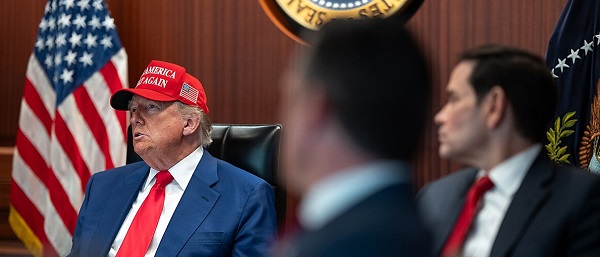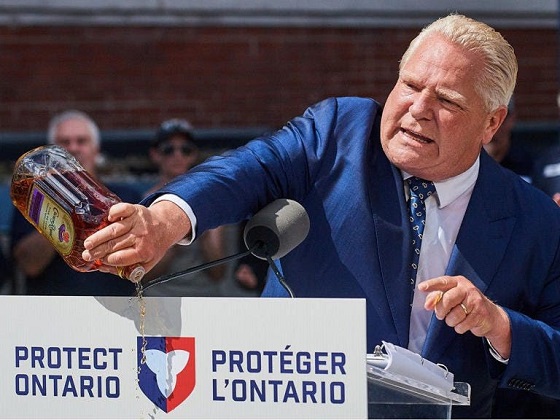Brownstone Institute
It Was Always About Control

From the Brownstone Institute
BY
Early on in March 2020 I was leery of the hysteria surrounding Covid and decided my course of action was to be wait and see. At the time I was under the impression that I was a freeborn citizen with a number of unalienable rights, including sovereignty over my bodily choices.
So when the talk started about new vaccines being imminent, I again decided I would wait and see whether the vaccines were all they were cracked up to be. This was then, and is now, an entirely reasonable position to take, screeching from media and Twitter hounds notwithstanding. I didn’t expect it would turn out to be more like “wait and see how totally out of hand this will get.”
- Wait and see how the government will forcibly close businesses
- Wait and see how treatments will be suppressed
- Wait and see how hysteria captured the media
- Wait and see how healthy populations will be subject to house arrest
- Wait and see how police will shoot protesters
- Wait and see how a pregnant mother will be arrested for a Facebook post
- Wait and see how medical services across state borders will be denied
- Wait and see how ‘wait and see-ers’ will be demonized
- Wait and see how family and friends will betray their loved ones
Well, I’ve waited long enough and I’ve seen more than enough. Thankfully the worst, most violent excesses have abated for now, if you exclude the ongoing carnage of short and long-term vaccine injury. There are lingering abominations from the blitzkrieg of lockdowns and vaccine mandates, but generally there is a sense that an uneasy peace, or maybe a phoney war, has descended on us.
Of course, there is still a serious amount of Covid pantomime going on.
Exhibit A: a TV news report recently showed a road accident victim doing rehab with a mask on, then happily chatting without a mask to the reporter, also without a mask. If he was worried about Covid he’d leave it on for the interview, or if he wasn’t worried he wouldn’t wear it while doing rehab. Seems you can have it both ways these days provided you don’t think about it too much.
Exhibit B: Last year cricket teams in the BBL were decimated if one of the players had a positive test, and others were ‘close contacts.’ Umpires refused to hold a bowler’s cap or sunglasses for fear of the spicy cough. Last night, two players on one team played despite not only testing positive, but also feeling unwell. If there is no practical change when a player has Covid, why do we need to know about it?
Answer: we don’t, but it has become normalised to disclose players’ private health statuses, just as it is normalised now to ask anyone any kind of detailed personal health question that satiates the questioner’s ghoulish fetishes. While player fitness has always been a matter of interest to sports fans, especially those who like a bet, illness used to be dealt with in a formulaic way, such as “Player X is not playing tonight due to illness.” There’s no need to know any further details.
Exhibit C: The memorial concert for aboriginal singer Archie Roach included a pre-concert ‘smoking ceremony’ in which footage aired for a news report showed a woman dancing through the ceremonial smoke – while wearing a mask. This example is probably less deliberate pantomime and more genuine irrationality. Anyone donning a mask and expecting to keep a virus out but let smoke in has taken leave of their rationality. Ironically, in this case the mask may actually do some good in preventing larger smoke particles entering the lungs – what firefighters call ‘smoke inhalation.’
It is counterproductive to scoff at these insanities – those who have not yet come in their own time to see the inconsistencies are not suddenly going to see the light because of a witty remark. The most likely reaction is an equally irrational, and possibly heated defence of the person or the rule. In valued relationships, the only sensible course is studied silence. Even a raised eyebrow in front of the TV can crank the tension in the room up a notch or two.
But these annoyances over masks and ‘Covid protocols,’ that overused euphemism for voodoo superstitions, are yesterday’s skirmishes in a war that has moved on to other theatres. The central battle is about freedom and autonomy. To the extent that the spoils of the ‘mask and protocol’ incursions can be re-weaponised against us, winning the freedom and autonomy battle will be that much harder.
How can we resist curbs on movement having once complied with QR scanning for going to the shops? Think it couldn’t happen? Oxford city council in the UK is moving ahead with a scheme to confine residents to one of 6 zones using electronic gates on roads and limited number of trips across zones.
How could we resist a forced medical treatment having once rolled over to experimental gene therapy? How can we fight against programmable digital currency when once we have accepted ‘card only’ cashiers and accommodated the idea of shopping for ‘essential items’ only and allowing a cop to rummage around in our shopping trolley?
The legislative bricks in the wall continue to be put into place with little if any scrutiny. Doctors are now unable to give opinions that depart from government health advice without risking de-registration. Pandemic laws born as bastard sons of parliaments suspended under state of emergency powers are now legitimised as permanent statutes, requiring only a declaration to bring them all into force once again. Digital ID’s are now compulsory for all company directors, including Mums and Dads who happen to be directors of their own superannuation funds. Ordinary citizens are surely next.
How is it that our lawmakers feel it appropriate to make these kinds of changes? No one asked for them. How is it they can ignore letters and petitions? Why do they partner with unelected globalists and make treaties we won’t be allowed to vote on? How is it that our civil rights institutions were so toothless? They didn’t even utter a whimper, let alone a growl. How is it that our professional bodies and business associations were silent?
Only a few brave souls protested. How is it that our police forces humiliated themselves to the point where they were taping off children’s playgrounds and fining elderly women for sitting on a park bench? We long ago gave up on the idea that the mainstream media would hold authorities to account.
In the end the explanations, whether we get them or not, whether they make sense or not, are beside the point. Nothing can change what happened. By some miracle we might avert what they have planned, but it’s going to be a hell of a fight.
Once upon a time, we sweated on daily case numbers when the new cases per day were less than 10; now we barely think of them, and they are in the thousands, if not the tens of thousands. There’s only one conclusion to be drawn – it was never about public health, and it still isn’t. It was always about control.
Reprinted from the author’s Substack
Brownstone Institute
Bizarre Decisions about Nicotine Pouches Lead to the Wrong Products on Shelves

From the Brownstone Institute
A walk through a dozen convenience stores in Montgomery County, Pennsylvania, says a lot about how US nicotine policy actually works. Only about one in eight nicotine-pouch products for sale is legal. The rest are unauthorized—but they’re not all the same. Some are brightly branded, with uncertain ingredients, not approved by any Western regulator, and clearly aimed at impulse buyers. Others—like Sweden’s NOAT—are the opposite: muted, well-made, adult-oriented, and already approved for sale in Europe.
Yet in the United States, NOAT has been told to stop selling. In September 2025, the Food and Drug Administration (FDA) issued the company a warning letter for offering nicotine pouches without marketing authorization. That might make sense if the products were dangerous, but they appear to be among the safest on the market: mild flavors, low nicotine levels, and recyclable paper packaging. In Europe, regulators consider them acceptable. In America, they’re banned. The decision looks, at best, strange—and possibly arbitrary.
What the Market Shows
My October 2025 audit was straightforward. I visited twelve stores and recorded every distinct pouch product visible for sale at the counter. If the item matched one of the twenty ZYN products that the FDA authorized in January, it was counted as legal. Everything else was counted as illegal.
Two of the stores told me they had recently received FDA letters and had already removed most illegal stock. The other ten stores were still dominated by unauthorized products—more than 93 percent of what was on display. Across all twelve locations, about 12 percent of products were legal ZYN, and about 88 percent were not.
The illegal share wasn’t uniform. Many of the unauthorized products were clearly high-nicotine imports with flashy names like Loop, Velo, and Zimo. These products may be fine, but some are probably high in contaminants, and a few often with very high nicotine levels. Others were subdued, plainly meant for adult users. NOAT was a good example of that second group: simple packaging, oat-based filler, restrained flavoring, and branding that makes no effort to look “cool.” It’s the kind of product any regulator serious about harm reduction would welcome.
Enforcement Works
To the FDA’s credit, enforcement does make a difference. The two stores that received official letters quickly pulled their illegal stock. That mirrors the agency’s broader efforts this year: new import alerts to detain unauthorized tobacco products at the border (see also Import Alert 98-06), and hundreds of warning letters to retailers, importers, and distributors.
But effective enforcement can’t solve a supply problem. The list of legal nicotine-pouch products is still extremely short—only a narrow range of ZYN items. Adults who want more variety, or stores that want to meet that demand, inevitably turn to gray-market suppliers. The more limited the legal catalog, the more the illegal market thrives.
Why the NOAT Decision Appears Bizarre
The FDA’s own actions make the situation hard to explain. In January 2025, it authorized twenty ZYN products after finding that they contained far fewer harmful chemicals than cigarettes and could help adult smokers switch. That was progress. But nine months later, the FDA has approved nothing else—while sending a warning letter to NOAT, arguably the least youth-oriented pouch line in the world.
The outcome is bad for legal sellers and public health. ZYN is legal; a handful of clearly risky, high-nicotine imports continue to circulate; and a mild, adult-market brand that meets European safety and labeling rules is banned. Officially, NOAT’s problem is procedural—it lacks a marketing order. But in practical terms, the FDA is punishing the very design choices it claims to value: simplicity, low appeal to minors, and clean ingredients.
This approach also ignores the differences in actual risk. Studies consistently show that nicotine pouches have far fewer toxins than cigarettes and far less variability than many vapes. The biggest pouch concerns are uneven nicotine levels and occasional traces of tobacco-specific nitrosamines, depending on manufacturing quality. The serious contamination issues—heavy metals and inconsistent dosage—belong mostly to disposable vapes, particularly the flood of unregulated imports from China. Treating all “unauthorized” products as equally bad blurs those distinctions and undermines proportional enforcement.
A Better Balance: Enforce Upstream, Widen the Legal Path
My small Montgomery County survey suggests a simple formula for improvement.
First, keep enforcement targeted and focused on suppliers, not just clerks. Warning letters clearly change behavior at the store level, but the biggest impact will come from auditing distributors and importers, and stopping bad shipments before they reach retail shelves.
Second, make compliance easy. A single-page list of authorized nicotine-pouch products—currently the twenty approved ZYN items—should be posted in every store and attached to distributor invoices. Point-of-sale systems can block barcodes for anything not on the list, and retailers could affirm, once a year, that they stock only approved items.
Third, widen the legal lane. The FDA launched a pilot program in September 2025 to speed review of new pouch applications. That program should spell out exactly what evidence is needed—chemical data, toxicology, nicotine release rates, and behavioral studies—and make timely decisions. If products like NOAT meet those standards, they should be authorized quickly. Legal competition among adult-oriented brands will crowd out the sketchy imports far faster than enforcement alone.
The Bottom Line
Enforcement matters, and the data show it works—where it happens. But the legal market is too narrow to protect consumers or encourage innovation. The current regime leaves a few ZYN products as lonely legal islands in a sea of gray-market pouches that range from sensible to reckless.
The FDA’s treatment of NOAT stands out as a case study in inconsistency: a quiet, adult-focused brand approved in Europe yet effectively banned in the US, while flashier and riskier options continue to slip through. That’s not a public-health victory; it’s a missed opportunity.
If the goal is to help adult smokers move to lower-risk products while keeping youth use low, the path forward is clear: enforce smartly, make compliance easy, and give good products a fair shot. Right now, we’re doing the first part well—but failing at the second and third. It’s time to fix that.
Addictions
The War on Commonsense Nicotine Regulation

From the Brownstone Institute
Cigarettes kill nearly half a million Americans each year. Everyone knows it, including the Food and Drug Administration. Yet while the most lethal nicotine product remains on sale in every gas station, the FDA continues to block or delay far safer alternatives.
Nicotine pouches—small, smokeless packets tucked under the lip—deliver nicotine without burning tobacco. They eliminate the tar, carbon monoxide, and carcinogens that make cigarettes so deadly. The logic of harm reduction couldn’t be clearer: if smokers can get nicotine without smoke, millions of lives could be saved.
Sweden has already proven the point. Through widespread use of snus and nicotine pouches, the country has cut daily smoking to about 5 percent, the lowest rate in Europe. Lung-cancer deaths are less than half the continental average. This “Swedish Experience” shows that when adults are given safer options, they switch voluntarily—no prohibition required.
In the United States, however, the FDA’s tobacco division has turned this logic on its head. Since Congress gave it sweeping authority in 2009, the agency has demanded that every new product undergo a Premarket Tobacco Product Application, or PMTA, proving it is “appropriate for the protection of public health.” That sounds reasonable until you see how the process works.
Manufacturers must spend millions on speculative modeling about how their products might affect every segment of society—smokers, nonsmokers, youth, and future generations—before they can even reach the market. Unsurprisingly, almost all PMTAs have been denied or shelved. Reduced-risk products sit in limbo while Marlboros and Newports remain untouched.
Only this January did the agency relent slightly, authorizing 20 ZYN nicotine-pouch products made by Swedish Match, now owned by Philip Morris. The FDA admitted the obvious: “The data show that these specific products are appropriate for the protection of public health.” The toxic-chemical levels were far lower than in cigarettes, and adult smokers were more likely to switch than teens were to start.
The decision should have been a turning point. Instead, it exposed the double standard. Other pouch makers—especially smaller firms from Sweden and the US, such as NOAT—remain locked out of the legal market even when their products meet the same technical standards.
The FDA’s inaction has created a black market dominated by unregulated imports, many from China. According to my own research, roughly 85 percent of pouches now sold in convenience stores are technically illegal.
The agency claims that this heavy-handed approach protects kids. But youth pouch use in the US remains very low—about 1.5 percent of high-school students according to the latest National Youth Tobacco Survey—while nearly 30 million American adults still smoke. Denying safer products to millions of addicted adults because a tiny fraction of teens might experiment is the opposite of public-health logic.
There’s a better path. The FDA should base its decisions on science, not fear. If a product dramatically reduces exposure to harmful chemicals, meets strict packaging and marketing standards, and enforces Tobacco 21 age verification, it should be allowed on the market. Population-level effects can be monitored afterward through real-world data on switching and youth use. That’s how drug and vaccine regulation already works.
Sweden’s evidence shows the results of a pragmatic approach: a near-smoke-free society achieved through consumer choice, not coercion. The FDA’s own approval of ZYN proves that such products can meet its legal standard for protecting public health. The next step is consistency—apply the same rules to everyone.
Combustion, not nicotine, is the killer. Until the FDA acts on that simple truth, it will keep protecting the cigarette industry it was supposed to regulate.
-

 Business1 day ago
Business1 day agoTrump’s Tariffs Have Not Caused Economy To Collapse
-

 Daily Caller1 day ago
Daily Caller1 day agoTrump Reportedly Planning Ground Troops, Drone Strikes On Cartels In Mexico
-

 Daily Caller2 days ago
Daily Caller2 days agoNigeria Would Welcome US Intervention In Massacre Of Christians By Islamic Terror Groups
-

 Alberta1 day ago
Alberta1 day agoAlberta government’s plan will improve access to MRIs and CT scans
-

 Automotive2 days ago
Automotive2 days agoCanada’s EV experiment has FAILED
-

 Alberta2 days ago
Alberta2 days agoCanada’s heavy oil finds new fans as global demand rises
-

 Bruce Dowbiggin2 days ago
Bruce Dowbiggin2 days agoA Story So Good Not Even The Elbows Up Crew Could Ruin It
-

 Addictions2 days ago
Addictions2 days agoThe War on Commonsense Nicotine Regulation











